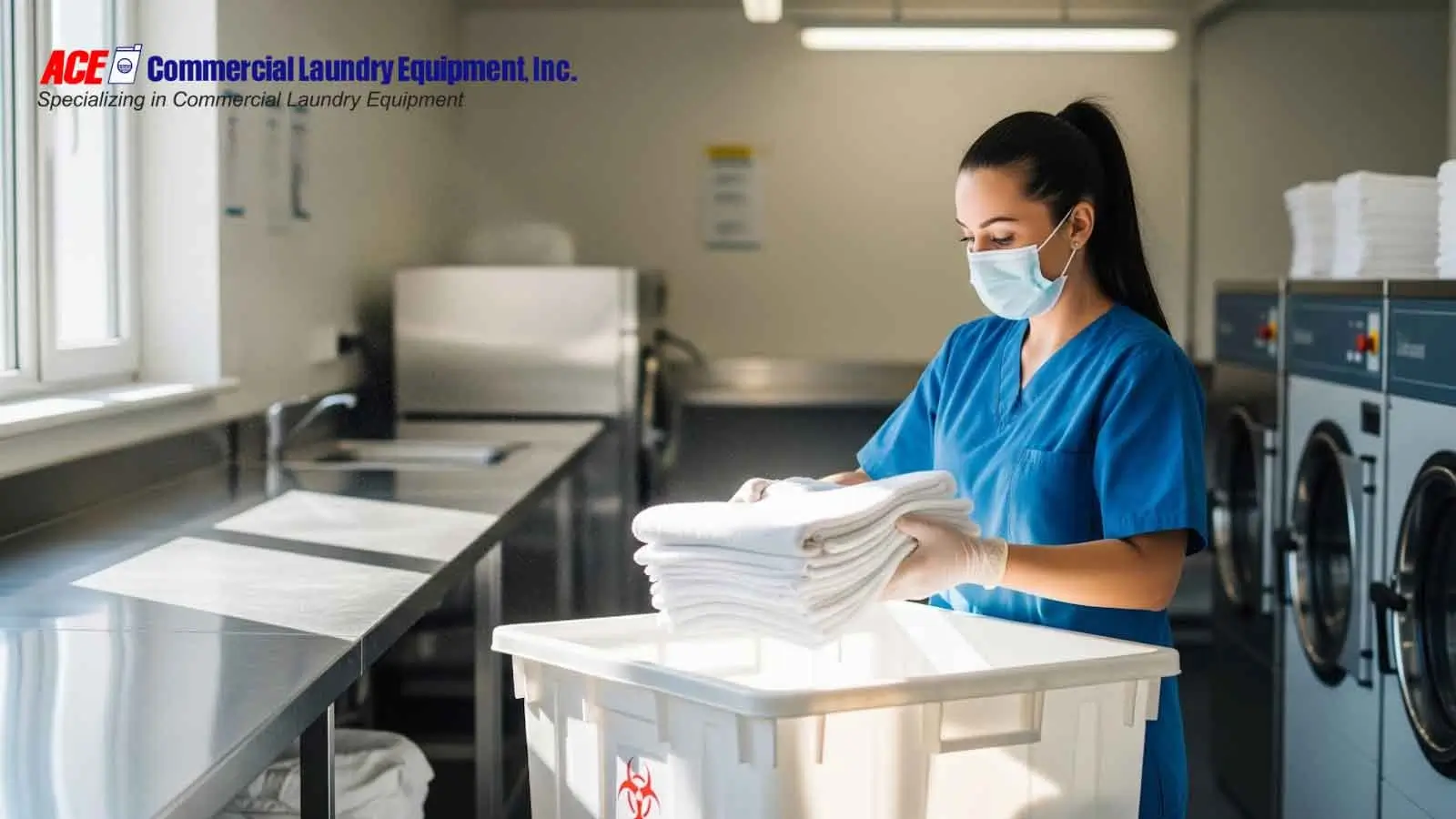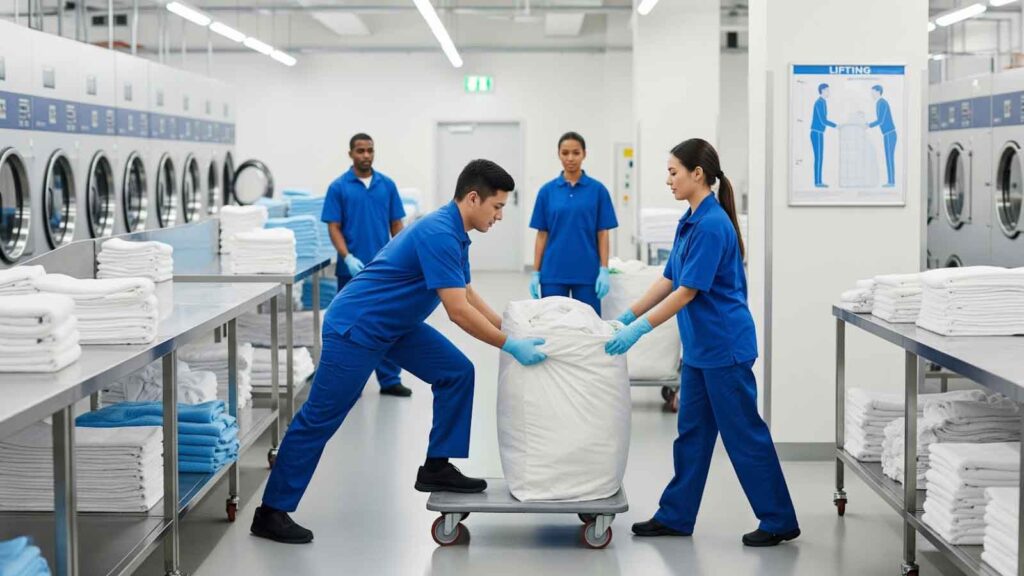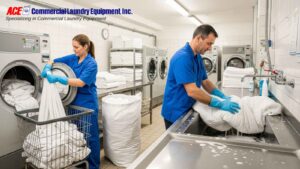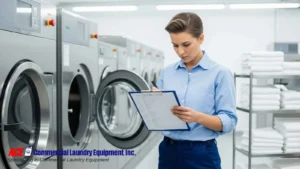Commercial laundry equipment is designed to handle heavy loads quickly, which makes it essential for many businesses. But if used carelessly, these powerful machines can cause injuries, damage fabrics, or even break down unexpectedly.
By learning a few simple safety habits, staff can protect themselves and keep equipment running efficiently.
This guide provides practical safety tips that anyone can follow, even without prior technical experience, ensuring your laundry room stays safe and productive.
Safe Operation and Maintenance of Laundry Equipment
Laundry machines are built to be strong, but they still need to be treated carefully. Following basic guidelines for operation and upkeep lowers the risk of accidents and keeps everything working as it should.
Always Follow Manufacturer Instructions
Each machine comes with directions for safe use, and ignoring them can lead to problems. Making sure staff understand these rules is the first step in preventing accidents.
- Read the equipment manual carefully: Manuals explain the correct way to use each machine, including cycle settings and safety notes. Taking the time to review these directions helps avoid errors that damage fabrics or the machine itself. Staff who are familiar with the manual can also solve minor issues without guesswork.
- Respect load sizes and settings: Overloading machines or choosing the wrong cycle can strain parts and reduce effectiveness. Sticking to the recommended limits ensures clothes are adequately cleaned and the machine lasts longer. It also lowers the risk of jams or overheating.
- Train staff on written guidelines: Written reminders placed near machines make it easier for staff to remember key rules. This helps standardize routines across shifts so safety doesn’t depend on one person’s memory. Consistency keeps operations smooth and safe.
Stay Alert and Focused During Operation
Even routine tasks can be risky if staff lose focus. Simple reminders about attention and timing can prevent accidents before they happen.
- Avoid distractions while machines are running: Phones, conversations, or multitasking can cause staff to overlook warnings or misuse equipment. Staying focused reduces the chance of injuries or damage. Clear policies about attention help set expectations.
- Take short breaks if tired: Fatigue often leads to mistakes, like misloading machines or skipping safety checks. Encouraging regular breaks keeps staff alert and reduces risk. Well-rested employees are safer and more productive.
- Never open doors or panels mid-cycle: Attempting to force machines open while they are running can cause burns, flooding, or mechanical damage. Teaching staff should wait until the cycles entirely stop to keep both themselves and the equipment safe. This habit also prevents costly downtime.
Inspect and Maintain Equipment Regularly
Machines last longer and perform better when they are checked and cleaned often. Regular maintenance is also one of the best ways to prevent accidents.
- Check hoses, belts, and filters for wear: Worn parts can snap or leak unexpectedly, creating safety hazards. Replacing them on schedule avoids sudden breakdowns. A simple inspection routine keeps problems small instead of turning into costly repairs.
- Keep machines and the area clean: Lint, dust, and spills create fire hazards and slip risks if ignored. Daily cleaning prevents buildup and keeps the workspace safe for everyone. Providing proper janitorial laundry supplies ensures staff can handle this task quickly.
- Let dryers finish their cool-down cycle: Stopping dryers too early, especially when greasy or oily fabrics are inside, can create fire risks. Allowing the cycle to complete lowers the chance of heat-related accidents. Staff should be trained to wait before unloading.
Handle Electrical and Mechanical Parts Safely
Machines have robust internal systems that can be dangerous if handled incorrectly. Only qualified people should ever access these areas.
- Limit internal access to trained staff: Panels, wiring, and moving parts carry risks of shocks or injury. Employees without training should never attempt to repair or open these areas. Clear rules reduce accidents caused by curiosity or guesswork.
- Always reinstall covers after servicing: Exposed wires or moving belts are unsafe and can injure anyone nearby. Putting covers back immediately after repairs ensures protection. Even short gaps in coverage can be dangerous.
- Provide good lighting and ventilation: A bright, well-ventilated workspace makes it easier to see hazards and work safely. Proper airflow also reduces the risk of overheating machines. These simple conditions support safer maintenance and operation.
Protecting Staff with Personal Safety Practices
Personal safety practices are simple steps every staff member can take to avoid injuries during daily work. These habits build a safer laundry room environment without requiring special knowledge.
- Wear protective gear: Gloves protect against germs and skin irritation when handling soiled linens, while goggles or face shields reduce the risk of splashes. Using gear consistently builds confidence in handling complex tasks. Protective items should be stored where staff can access them quickly. When used correctly, they prevent accidents that might otherwise be overlooked.
- Choose proper footwear: Non-slip shoes are essential in laundry rooms, where water or detergent often ends up on the floor. They reduce the chance of slips that can lead to serious injuries. Shoes should also be closed-toe to protect feet from dropped items. Requiring this footwear keeps the workplace safer for everyone.
- Practice good hygiene: Regular handwashing after handling dirty laundry prevents germs from spreading. Staff should also wash their hands before breaks or meals to protect their health. Hygiene rules remind employees that safety extends beyond machines. Clean habits keep both workers and customers safe.
- Lift loads safely: Heavy bags or baskets of laundry can strain the back and shoulders if lifted incorrectly. Staff should bend their knees and keep loads close to their body when lifting. Using carts or trolleys for larger items prevents injuries from overexertion. Safe lifting techniques protect employees from long-term strain.
- Stay hydrated and alert: Working in warm laundry environments can cause fatigue and dehydration. Drinking water regularly keeps staff focused and reduces the chance of mistakes. Alert employees are less likely to overlook hazards or skip safety steps. Encouraging hydration breaks supports both health and productivity.
Staying Safe Around Chemicals
Laundry rooms use detergents, disinfectants, and stain removers that must be handled carefully. Clear chemical safety practices protect both staff and fabrics.
- Read labels carefully: Each product includes instructions for safe use and hazard warnings that should not be ignored. Staff should understand what the symbols mean before opening containers. Training them to double-check labels prevents misuse that could damage laundry or cause harm. Clear reading habits save time and reduce risks.
- Store products safely: Chemicals should remain in their original containers with lids closed tightly. Proper storage prevents spills, leaks, or dangerous mixing of products. Keeping them in a designated area reduces confusion for new staff. Organized storage also ensures emergency responders know exactly what is present.
- Have Safety Data Sheets (SDSs): SDSs explain what to do if an accident occurs with a chemical. They should be stored in a visible, easy-to-reach location for staff. Reviewing these sheets during training ensures employees know what steps to take. Accessible SDSs prepare staff to react calmly and correctly.
- Clean spills immediately: Spilled detergents or bleach create both slip hazards and risks of skin contact. Staff should be trained to use the right cleaning materials for each type of spill. Acting quickly prevents the problem from spreading to other areas. Keeping cleaning kits nearby makes fast action possible.
Handling Contaminated Laundry Safely
Contaminated laundry can include items soiled with bodily fluids, chemicals, or heavy dirt. These materials require extra care to protect staff and prevent the spread of germs or irritants. The following practices keep both employees and customers safe while ensuring proper cleaning.
- Wear gloves at all times: Gloves act as a barrier against bacteria, viruses, and irritants that may be on fabrics. Staff should replace gloves immediately if they tear or become overly soiled. Using disposable gloves reduces the chance of germs spreading to other loads. Having gloves available near the sorting area makes compliance easier.
- Keep loads separate: Contaminated laundry should always be washed apart from regular items. Mixing it with other fabrics risks spreading germs to clean clothing. Designating specific machines or cycles for contaminated items is even safer. This practice reassures customers that their laundry is not exposed to unsafe conditions.
- Minimize agitation: Shaking or tossing contaminated fabrics can release dust, lint, or pathogens into the air. Instead, items should be loaded carefully and directly into the machine. This lowers the risk of particles spreading onto other surfaces or staff. Calm handling keeps the work environment cleaner and safer.
- Use the proper water temperature and detergents: Hot water and strong detergents are often recommended for contaminated loads. These settings help kill bacteria and remove harmful substances effectively. Training staff on when to use these options ensures fabrics are cleaned thoroughly. Correct choices also reduce the risk of recontamination later.
- Disinfect machines after use: Once a contaminated load is finished, machines should be cleaned before regular laundry is processed again. Wiping down doors, drums, and surfaces with approved disinfectants eliminates lingering germs. This step keeps the equipment safe for the following user. Making disinfection part of the routine prevents long-term buildup of harmful residues.
Take the Next Step Toward Safer Laundry Operations
Keeping staff safe around commercial machines isn’t just best practice; it protects your people, your equipment, and your reputation. If safety feels overwhelming, our team at Ace Laundry is here to make it easier.
With our Full-Service Laundry Room Management, we don’t just provide machines; we help design, install, and maintain them so safety is built into every step. Our equipment lineup includes durable Huebsch washers and commercial dryers, built for heavy use and designed with safety in mind.
For multi-housing properties, hotels, or healthcare facilities, our On-Premise Laundry (OPL) solutions give you complete control over safety and efficiency. We also back you with parts, technical support, and regular maintenance services so issues like worn belts or faulty seals are resolved before they put staff at risk.
If you want your team to work confidently and safely, explore our reliable machines, safety-focused installations, and ongoing support. Contact us and visit Ace Laundry today to see how our services can protect your staff and keep your laundry operation running smoothly.
Read Also: How Hotels Can Streamline Laundry Operations





